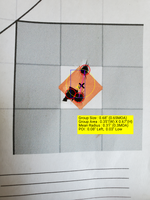- Thread starter
- #21
jerbearyukon44
Beginner
- Jul 28, 2024
- 101
- 61
I have lots of IMR 3031 I use that in my 45-70 loads
So I have some options
Thanks Jer
So I have some options
Thanks Jer
Follow along with the video below to see how to install our site as a web app on your home screen.

Note: this_feature_currently_requires_accessing_site_using_safari
FWIW, you can use load data from other reputable sources (Hodgdon, other bullet manufacturers, etc) where other standard 100gr bullets are being loaded (such as the Sierra Game King). It doesn't have to be data specifically for the Nosler Partition. Just start near the bottom and work your way up the load range.Didn’t see this one thanks
JD338, my personal experience, if the rifles are same maker and model, it would be pretty close. I have 3 WBY MKV 300, one Japenese Deluxe and 2 US Accumark. All three shoot 200 AB or 200 PT to 300 yards, same load, very close. I could fine tune more, but no need for their intended purpose.False, every rifle is different.
JD338
Sure, because they are built to pretty much the same spec. But I don't think that applies here, as the suggested load was not being used in another Henry Long Ranger, as I understand it. In fact, I believe it was a bolt gun (vs a lever action). Quite a bit of difference.JD338, my personal experience, if the rifles are same maker and model, it would be pretty close. I have 3 WBY MKV 300, one Japenese Deluxe and 2 US Accumark. All three shoot 200 AB or 200 PT to 300 yards, same load, very close. I could fine tune more, but no need for their intended purpose.
True. Rifles have to be very simillar, and will still need to develope of the rifle. I only have two Brands/Models of bolt action. Win M70 Classic Stainless and WBY MKV. I have occasionally used loads from my friends with same brand/model/caliber for starting loads, but not before checking with 2-3 loading manuals to make sure the load is safe to beging with. I also run Gordons and QL. I am by no means suggesting others do this, I am just saying it has worked for me.Sure, because they are built to pretty much the same spec. But I don't think that applies here, as the suggested load was not being used in another Henry Long Ranger, as I understand it. In fact, I believe it was a bolt gun (vs a lever action). Quite a bit of difference.

That load "will kill"7828 is my favorite.

This is from a 249 dollar Savage axis.
My point is production guns are just that production. There can be differences in barrels such as rifling and chambering. ie: worn vs. new, etc. Tolerance stack ups can also make a difference , especially when comparing different manufacturers.JD338, my personal experience, if the rifles are same maker and model, it would be pretty close. I have 3 WBY MKV 300, one Japenese Deluxe and 2 US Accumark. All three shoot 200 AB or 200 PT to 300 yards, same load, very close. I could fine tune more, but no need for their intended purpose.
Good stuffStarline
Not far behind you with my $300 Marlin. I shot this the other day while checking a load. I had previously developed the load with IMR 4064, 70gr Nosler Varmageddon, WLR primers, and Federal brass. But I wasn't satisfied with the short life of the brass, so I moved it to Starline instead. Backed off a grain on the powder and worked it back up. The sweet spot with the Starline brass was .2gr less than with the Federal, but shot to the same POI.7828 is my favorite.

This is from a 249 dollar Savage axis.

It’s usually a powder that isn’t available to reloaders but it may be pretty close to something available in some cases. I imagine that in some cases it may even be the same as what is available to us but impossible to know for sure. Add a pic if you want, we can guess but don’t take it to the bank…Hey is there a way to tell what a factory load is using for powder?
I pulled a federal 100 grain 243 shok bullet apart with my new Hornady puller today just to try it out.
It had 43.3 grains of some pretty small powder half the size easily of what 4350 looks like.
I could take a pic of both if someone knew what it might be.
Does anyone else do this or is it a mute point,
Thanks Jer
Quiet often commercial loads use custom powders that are not readily available to the public.